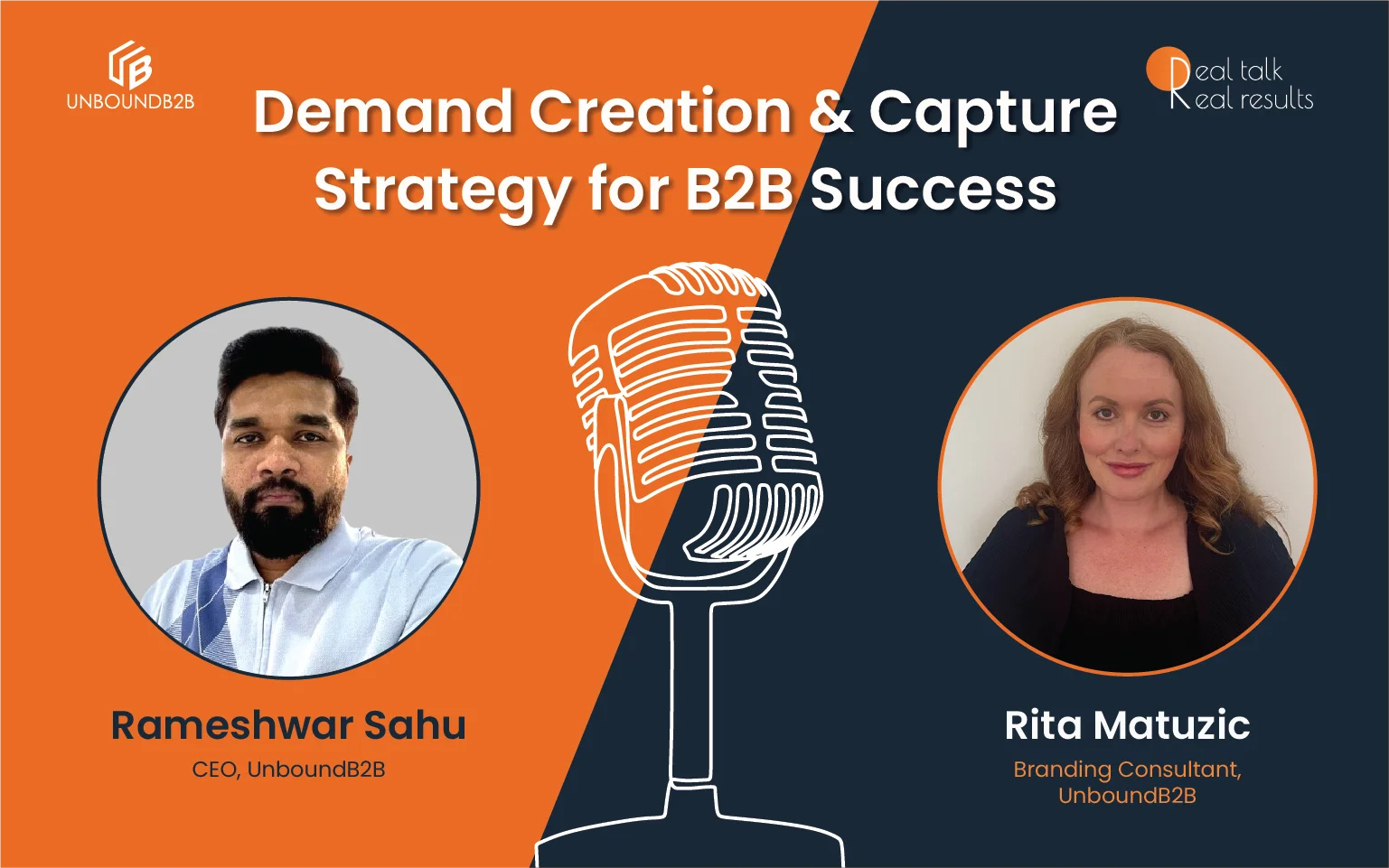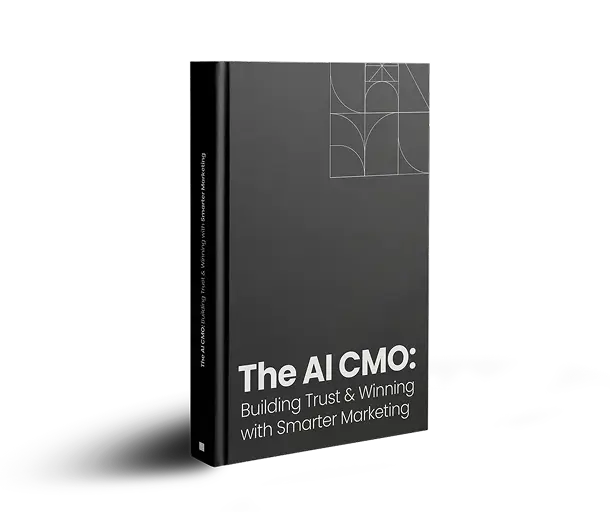
What is the difference between demand creation vs demand capture? How do you break down key differences and know which one to use in your B2B marketing strategy?
In this conversation on the Real Talk Real Results podcast, Ram Sahu, Co-founder and CEO of UnboundB2B, shares everything you need to know about effectively implementing demand tactics into your go-to-market strategies. With over a decade of experience in the GTM and B2B marketing space, Ram shares his expert perspective on how to drive pipeline and revenue growth by striking the right balance between the two.
UnboundB2B: How do you break down the key differences between demand creation and demand capture? And how do they fit into an effective B2B marketing strategy?
Ram: Demand creation and demand capture are two different marketing functions, and both require different strategies. Are you familiar with the 95/5 rule?
A recent B2B study found that 95% of your target audience is not in the buying cycle. They may not be ready for the next 9 to 18 months, depending on their buying cycles and marketing budget allocation. So, you’re only left with 5% of your target market ready to buy right now.
That 5% is a very small audience—yet it’s exactly where demand capture comes into play.
A typical demand capture strategy uses both creative and paid media strategies, such as search engines and social media. In other words, where people are showing clear high intent using certain keywords.
You direct them to your website, they find your solution, and you capture that lead. But the challenge is, when a customer finds your website, they’ve probably also inquired with three to four other vendors, and you are immediately competing.
You’re competing on price, features, and services. Unless, of course, you’re SpaceX and doing things nobody else is doing. For the rest of us, you are probably just another vendor in the mix to your audience.
Demand capture is important because it helps you build a short-term pipeline. But demand creation is where you’re building a long-term pipeline, in contrast, because when 95% of buyers are ready to make their purchase, 80% of them buy from a known brand. Demand creation helps your brand stay top-of-mind when they are ready.
Demand creation requires a different strategy. It’s primarily about brand positioning, your messaging, and the creative pieces you use for your target audience. Then you break that down into channels—whether you use programmatic advertising, a LinkedIn promotion strategy, or promote your brand through other platforms like Reddit, G2Crowd, and TrustRadius—where your audience is currently visiting.
From there, you convert those engagements and brand awareness into top-of-funnel leads, which become your community. You can use email automation, SDR sequences, or whatever suits your company and team size to nurture those leads over 6 to 12 weeks before qualifying them as sales-qualified leads (more on that notion shortly).
I am a big advocate of demand creation strategy because it can drive long-term, consistent results. But demand capture is also important to deliver short-term goals. Finding the balance will depend on your goals and marketing budget allocation.
UnboundB2B: How do you think B2B marketers should split their budgets between demand capture vs demand creation?
Ram: Again, it depends on where your brand is on your marketing journey. To give a straightforward answer, 60-40 is a great balance. 60% demand creation and 40% demand capture.
But again, it does vary depending on how big your company is. What is your total addressable market (TAM), the size of the total number of accounts that you’re addressing, and your budget? With a larger TAM and bigger budget, 60/40 might work for you.
If you don’t have the budget to go after all that, consider an Account-Based Marketing (ABM) strategy that suits your budget. So, you identify just enough companies that you can educate with that budget, so that your ad or marketing spend isn’t spread too thin.
While field marketing budgets often get treated separately, they should be included in your demand creation strategy. Field marketing gives you more visibility, helps build your brand, and creates a community.
UnboundB2B: What marketing metrics can determine success in your demand capture and demand creation strategy?
Ram: When it comes to measuring success in demand creation, the metric shouldn’t be leads. It should be engagement.You should be asking:
- How many accounts in your ICP are engaged?
- How many contacts are showing high engagement scores?
- How many accounts are showing higher intent scores?
You can have more leads, but that doesn’t necessarily mean better ROI. More leads are not equal to better ROI. Engagement metrics tell you where your future pipeline will come from.
For demand capture, ROAS (return on ad spend) becomes the metric. You can calculate ROI based on leads to sales-qualified opportunities, opportunities to closed-won deals, and average selling price. But you have to watch out—demand capture is highly competitive, and your cost per lead can spike if competitors are bidding at the same time on the same keywords.
Companies that balance both demand capture and a demand creation strategy see a 70% higher return over a 12 to 24-month period. Why? You’re educating prospects while also capturing them when they’re ready to buy. This funnel optimizes both aspects. The moment a prospect moves from not being in the market to being in the market, they’re already educated about you. You’re also capturing them at the same time, making it the ideal go-to-market strategy.
UnboundB2B: What should marketers consider when they think about the concept of a qualified lead?
Ram: Traditionally, a qualified lead is someone who fits BANT criteria or is willing to take a demo. I do not believe that.
If a prospect is willing to engage in a conversation, they’re automatically a sales-qualified lead. Time is valuable. Why would somebody spend their time with you if they’re not interested?
Especially with ABM strategies, where you’re working with a finite number of accounts and a finite number of buyers. Once you get through your target list, then what? Lead acquisition isn’t a sustainable measure anymore. You need to find that balance where you can keep educating your prospects and keep them engaged.
UnboundB2B: How can B2B Marketers shift their focus to prioritize engagement over lead generation?
Ram: Education starts at the top. If you have a demand gen leader in a B2B company that has an ABM strategy and only measures lead goals, then there’s a problem with it. But it goes beyond that. It starts right at the CEO and CMO level, where the companies need to understand what their GTM strategy is and not just depend on their managerial or marketing team to make those decisions for them.
Building a brand is so important before you get to demand generation. I think “BrandGen” is a newer term coined by a few agencies, and it’s being used widely today. But I think focusing on brand gen is more important than just focusing on demand generation.
You have to constantly work on educating your prospects. The number one problem marketers have is that they think they know everything. They forget how often their market demographic changes, and this isn’t just marketers who’ve been around for a while. You need an ongoing review mechanism to prevent this.
Constantly understanding your market may require using an analyst firm, running some surveys, creating a community, and asking questions to that community. That makes sense because, first of all, you need to know what they want. That changes everything.
That ties into your brand positioning, your messaging that you’re building, and then the creatives around that. Otherwise, you can focus on what’s worked in the past, but you have to have the data to support it. Just remember to eventually create a mechanism that reviews what your customers want.
Are You Hitting Your Pipeline Goals By Balancing Demand Capture with Your Demand Creation Strategy?
Ultimately, everybody wants ROI, and if you’re hitting your ROI goals, none of the other metrics matter. Companies that balance demand creation strategy with demand capture (educating prospects while capturing demand) see a 70% higher return over 12 to 24 months. That’s because their speed to market is higher, and they close that gap quickly through a dynamic, two-pronged strategy.
Of course, you can’t just turn on the demand engine and leave it alone. Remember to refresh your creatives and to consistently review what your prospects want. By balancing both strategies effectively, you can grow your ROI and drive long-term, consistent results!
Learn how a strategic demand creation approach can position your brand for long-term success.
Our blog
Latest blog posts
Tool and strategies modern teams need to help their companies grow.

Marketers often confuse drips vs nurtures, but each plays a distinct role in B2B emai...

This article explores the key differences between enterprise sales vs SMB sales, high...

AI in B2B marketing, future of B2B marketing, ai in marketing, ai in marketing automa...







